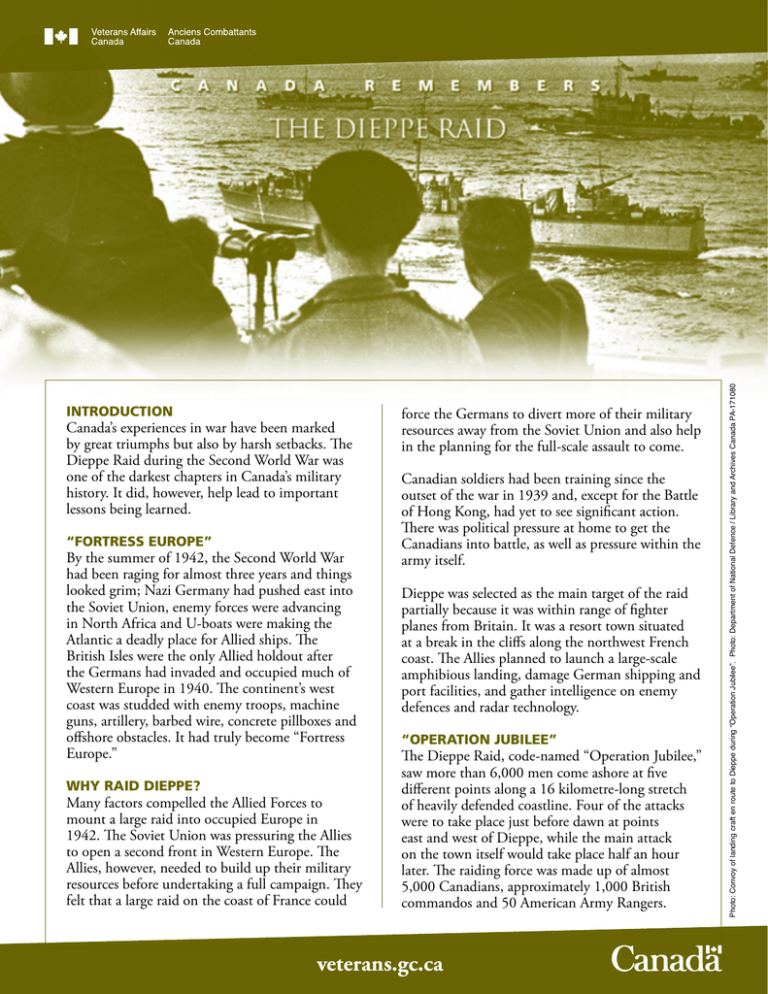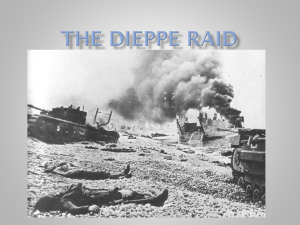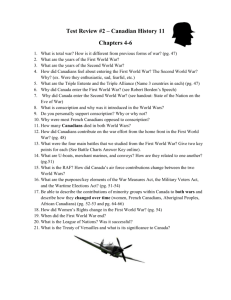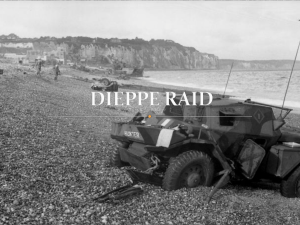force the Germans to divert more of their military
advertisement

Canada’s experiences in war have been marked by great triumphs but also by harsh setbacks. The Dieppe Raid during the Second World War was one of the darkest chapters in Canada’s military history. It did, however, help lead to important lessons being learned. “FORTRESS EUROPE” By the summer of 1942, the Second World War had been raging for almost three years and things looked grim; Nazi Germany had pushed east into the Soviet Union, enemy forces were advancing in North Africa and U-boats were making the Atlantic a deadly place for Allied ships. The British Isles were the only Allied holdout after the Germans had invaded and occupied much of Western Europe in 1940. The continent’s west coast was studded with enemy troops, machine guns, artillery, barbed wire, concrete pillboxes and offshore obstacles. It had truly become “Fortress Europe.” WHY RAID DIEPPE? Many factors compelled the Allied Forces to mount a large raid into occupied Europe in 1942. The Soviet Union was pressuring the Allies to open a second front in Western Europe. The Allies, however, needed to build up their military resources before undertaking a full campaign. They felt that a large raid on the coast of France could force the Germans to divert more of their military resources away from the Soviet Union and also help in the planning for the full-scale assault to come. Canadian soldiers had been training since the outset of the war in 1939 and, except for the Battle of Hong Kong, had yet to see significant action. There was political pressure at home to get the Canadians into battle, as well as pressure within the army itself. Dieppe was selected as the main target of the raid partially because it was within range of fighter planes from Britain. It was a resort town situated at a break in the cliffs along the northwest French coast. The Allies planned to launch a large-scale amphibious landing, damage German shipping and port facilities, and gather intelligence on enemy defences and radar technology. “OPERATION JUBILEE” The Dieppe Raid, code-named “Operation Jubilee,” saw more than 6,000 men come ashore at five different points along a 16 kilometre-long stretch of heavily defended coastline. Four of the attacks were to take place just before dawn at points east and west of Dieppe, while the main attack on the town itself would take place half an hour later. The raiding force was made up of almost 5,000 Canadians, approximately 1,000 British commandos and 50 American Army Rangers. veterans.gc.ca Photo: Convoy of landing craft en route to Dieppe during “Operation Jubilee”. Photo: Department of National Defence / Library and Archives Canada PA-171080 INTRODUCTION Things immediately went wrong for the landing force on the eastern flank. They met a small German convoy and the ensuing firefight alerted the enemy. The forces that came ashore at Berneval and Puys were met with overwhelming fire and some of the heaviest Allied losses took place there. Canadians captured at Dieppe. Photo: Library and Archives Canada C-014171 Some objectives on the western flank were met and the enemy gun batteries at Varengeville were destroyed. In Pourville, the South Saskatchewan Regiment and the Queen’s Own Cameron Highlanders came ashore and pushed towards their goals. The mounting German resistance, however, forced them to withdraw with heavy losses. Running behind schedule, the main force going ashore at Dieppe landed as daylight was breaking. The alerted German troops cut down many Canadians as they waded in the surf. Nevertheless, many fought their way across the cobblestone beach to the protection of the seawall. The same cobblestones and seawall made it hard for the Allied tanks to move off the beach and the fierce enemy fire prevented engineers from clearing the way for the tanks. Small groups from the Royal Hamilton Light Infantry and the Essex Scottish Regiment were able to fight their way into the bullet-swept streets of Dieppe. It was clear, however, that the raid could not continue and the retreat began. Trying to evacuate everyone would mean the destruction of the Allied naval force. Through great courage, many men were taken off the beaches under heavy fire, but by early afternoon the last boat had departed. Left in a hopeless situation, the remaining Canadians were forced to surrender. The raid was over. GREAT VALOUR Many acts of great courage took place during the Dieppe Raid and two men would earn the Victoria Cross (VC), our country’s highest medal for military valour. Lieutenant-Colonel Cecil Merritt earned his Victoria Cross for courageously leading men from the South Saskatchewan Regiment across the River Scie at Pourville in the face of heavy resistance. Once the regiment could go no farther, he led a dangerous retreat that allowed most of the men to escape back to Britain. He was captured and spent the rest of the war as a prisoner of war (POW). Reverend John W. Foote, a chaplain with the Royal Hamilton Light Infantry, also earned a Victoria Cross. For eight hours, he continually braved enemy fire on the beach to bring the wounded to first aid posts. When his own landing craft was about to leave, he jumped ashore to be captured so that he could minister to the many Canadians who were taken as POWs. LESSONS LEARNED 1942 was one of the darkest periods of the Second World War. But the fact that the Allies came ashore in occupied France gave the French hope and the Dieppe Raid let them know that they had not been forgotten. SACRIFICE The beach after Dieppe Raid. Photo: DVA 734–41 The men who participated in the Dieppe Raid paid a great price. Of the 4,963 Canadians who went on the mission, only approximately 2,200 returned to England and many of them were wounded. More than 3,350 Canadians became casualties, including approximately 1,950 taken as POWs. 913 Canadians died on the beaches, as German captives, or of their wounds after returning to England. A total of 210 British and Americans also lost their lives. Those who were captured faced especially harsh treatment in POW camps and most would remain in captivity for more than two-and-a-half years. As the end of the war neared, many Dieppe POWs also had to endure forced wintertime marches. These marches were ordered by the Germans as they moved the POWs away from the advancing Allies working to liberate them. The Dieppe Raid also took a considerable toll on the ships and aircraft that supported the assault. The campaign saw the war’s single worst day for Allied aircraft losses, with 119 aircraft shot down as they protected the supporting ships. LEGACY The Canadians who participated in the Dieppe Raid were among the more than one million men and women from Canada who served in uniform during the Second World War. The efforts of all of these Canadians helped ensure that victory was achieved. The sacrifices and achievements of those who gave so much to restore peace and freedom to the world cannot be forgotten. CANADA REMEMBERS PROGRAM The Canada Remembers Program of Veterans Affairs Canada encourages all Canadians to learn about the sacrifices and achievements made by those who have served—and continue to serve— during times of war and peace. As well, it invites Canadians to become involved in remembrance activities that will help preserve their legacy for future generations. To learn more about Canada’s role in the Second World War, please visit the Veterans Affairs Canada Web site at veterans.gc.ca or call 1-866-522-2122 toll free. This publication is available upon request in alternate formats. © Her Majesty the Queen in Right of Canada, represented by the Minister of Veterans Affairs, 2011. Cat. No.: V32-198/1-2011E-PDF ISBN: 978-1-100-17823-3 Printed in Canada While many men were lost and the raid did not meet most of its objectives, many historians feel that the lessons learned played an important role in the success of later actions. For example, the Dieppe Raid and later beach assaults contributed to improvements in amphibious landing techniques. While the cost of gaining this knowledge was steep, it likely saved many lives on the beaches of Normandy when the Allies returned to the shores of continental Western Europe on D-Day, June 6, 1944.






